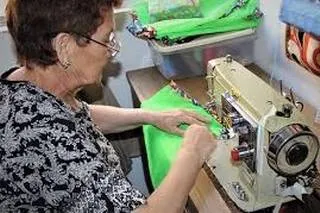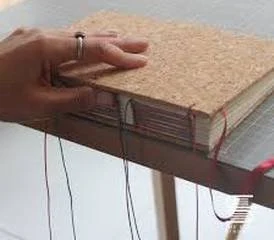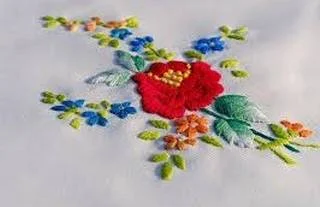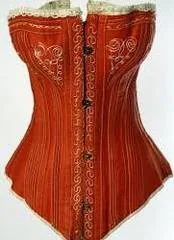Sewing
Sewing is the art of
joining or attaching objects using stitches made with the help of needles and
thread. It is one of the oldest textile arts in the Paleolithic period Prior to
the discovery of spinning yarn or fabric, archaeologists across Europe and Asia
believed that the Stone Age people sewed fur and skin garments using bones,
antlers, or ivory needles and threads made from various parts of the animal's
body, including sinew, catgut, and veins.
For thousands of years, all sewing in garments or clothing was done by hand. In the 19th century, the invention of
the sewing machine and the rise of computerization in the
twentieth century led to mass production and export of sewing materials, but
still, hand sewing is practiced all over the world. Fine hand stitching is
followed by textile artists and hobbyists as a means of high-quality tailoring,
haute couture fashion and custom dressmaking, and creative expression.
History of sewing
There is an ancient history of sewing which is
believed to have started during the Paleolithic era. Sewing was used to
secretly sew animals for clothing and shelter. Native Americans and Canadian
Prairies used sophisticated sewing methods to assemble tipi shelters. Sewing
was mixed with the weaving of tree leaves in Africa to make baskets, like those
made by Zulu weavers, who used thin strips of palm leaves to sew wide strips of
palm leaves as a thread. The weaving of cloth from natural fibers began in the
Middle East around 4000 BC and probably preceded the Neolithic period and the
development of textile sewing.
For the most part, sewing was a woman’s
profession, and for the most part, sewing was practical before the 19th
century. Clothing was an expensive investment for most people and women played
an important role in increasing the longevity of clothing items. Used for
sewing. Once the garment is worn or torn, it will be taken apart again and the
reusable fabric will be sewn together into new items of the garment, made into
fillings, or otherwise put into practical use. Embroidery like embroidery was a
valuable skill and young women with time and means practiced building their
skills in this field. From the Middle Ages to the 17th century, many European
brides had sewing tools, such as needles, pins, and pincushions, in trousseaus.
List of sewing occupations
Dressmaker
A dressmaker is a person who makes traditional
clothes for women like dresses, blouses, and evening gowns. A garment maker is
also called a mantua-maker, modiste, or fabric. Dressmaker refers to clothing
made in the style of a dressmaker, often the word desk maker's description
includes raffles, frills, ribbons, or bread trim. Since the rise of casual wear
in the middle of the twentieth century, the dressmaker has become relatively
usable in this sense.
Tailoring
Tailoring is a technique that makes, repairs, or
changes clothing professionally, especially suits and men's clothing. The term
thus used refers to a set of specific hand and machine sewing and pressing
techniques that are unique to the construction of conventional jackets. Small
and medium-sized retail tailors travel to different cities to provide their
services internationally with individual tailors and cutters, meet customers
locally, are measured on one trip, fitted on another, and then clothing is
delivered without the hassle of traveling abroad. Even small sewing businesses
without international follow-up can sometimes travel from one city to another
within their own country, and the vast majority of customers go to their places
of work or home.
Bookbinding
Bookbinding is the method of physically collecting a
book of codex formats from an ordered stack of sheets of paper that are divided
into sections or sometimes left as stacks of individual sheets. The stack is
then sewn with thread through the folds or tied along one end by a layer of
flexible adhesive. Other techniques of binding that are cheaper but less
durable include loose-leaf rings, twin loop spine coils, plastic spiral coils,
and plastic spine ropes, individual screw posts, or binding posts. For safety,
the bound stack is either wrapped in a flexible cover or attached to rigid
boards. Finally, interesting cover boards adhere, including information and
decor identification. Even a book artist or book decorating expert can greatly
enhance the content of a book by creating things like books with exceptional
quality artistic merit.
Embroidery
Embroidery
is the arrangement of crafts on fabric or other materials using yarn and
needles. Embroidery can include
other elements like pearls, beads, quills, and sequins. In present times,
embroidery is usually seen on caps, dresses, stockings, hats, dress shirts,
denim, coats, blankets, and golf shirts. The embroidery is available in a
variety of threads or yarns. Some basic techniques of embroidery are
chain sewing, buttonhole or blanket sewing, running sewing, satin stitch,
cross-sewing. Those stitches still exist today as a basic technique of hand
embroidery.
Draper
The draper was originally for a clothing seller or cloth wholesaler. It was originally a dropper for clothing that could additionally act as a cloth merchant or haberdasher. A dropper is now defined as a highly-skilled role in the fashion industry. This costume is decorated with the work of creating costume costumes or patterns in the studio of fashion design or costume design by drawing the fabric in the form of clothing; Draping uses a human form to place the fabric in the physically desired pattern. An alternative method of drafting is when the garment is started from the measurement on paper. Fashion draperies can also be known firsthand because they are often the most skilled creators of workshops and the first to work with fabrics for a wardrobe. However, in the clothing studio, the first hand is often the helper of the dropper.
Corset
A corset is a garment that traditionally supports a small waist or larger bottom, for aesthetic or therapeutic purposes, or breasts, to hold and train the torso to the desired shape. Both men and women are wearing corsets, although this item has been an integral part of women's wardrobes for many years. Since the end of the twentieth century, the term corset has been borrowed to refer to the tops of the fashion industry that, to varying degrees, mimics the look of traditional corsets without acting like them. Although these modern corsets and corset tops often characteristic lace or boning and generally mimic a historical style corset, their wear is minimal, if any, it affects the wearer's body size. Genuine corsets are usually made of a corset and are often worn by individual wearers.














0 Comments